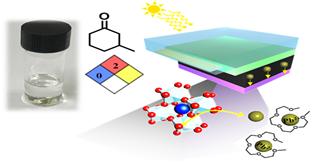
Credit: Taiho Park (POSTECH)
Solar energy that reaches the Earth is about 125 million gigawatt (Gw). When this solar energy generated for a year is converted into oil, it is 100 trillion ton which is ten thousand times more than the amount of oil energy the world uses in a year. So, it is no surprising when one of the coffee commercial ads said, “The sunlight reaching the Earth for 30 seconds is enough for the entire world to use energy for 48 hours.” Converting this solar energy into electrical energy is solar cell energy. Recently a research team from POSTECH developed an eco-friendly organic electronic material technology to solve an environmental issue which can occur during the production process of the conventional perovskite solar cells.
POSTECH research team consisted of Prof. Taiho Park and Junwoo Lee, a student in joint MS-PhD program developed Alkoxy-PTEG, hole transport polymers that could be dissolved in peppermint oil, by applying ethylene glycol side chains when they produced high efficiency perovskite solar cells. Also, they confirmed that this polymer captured leaking lead in the aged perovskite solar cells.
The essential material of a solar cell is photoactive layer which absorbs solar energy. Perovskite uses materials with crystal structures as photoactive layers and its distinctive feature is absorbing lights very well which is possible by using cheap inorganic and organic materials. For this reason, it is referred to as ‘next-generation solar cell.’ But the problem is that organic materials of transport layer used in a solar cell uses toxic chemical solvent in the production process and can harm environment and humans and therefore cannot be mass produced. In addition, when lead in the perovskite becomes aged, it can leak.
They designed and synthesized new polymers so that they can be dissolved in peppermint oil (3-methylcyclohexanone) or walnut aromatic food additives (2-methyl anisole), which could replace the toxic chemicals used previously. This made a green process possible.
The research team processed the perovskite solar cells using peppermint oil as a solvent without any chemical additives and the solar cell efficiency reached 19.9% and 21.2% when walnut aroma food additives were used. Furthermore, disadvantage of the conventional perovskite solar cell is that it has low stability because it is weak to moisture and when there is water its photoelectric conversion efficiency decreases dramatically. The newly developed polymers, however, overcame the disadvantage. The research team verified that they kept 88% efficiency after 30 days passed and exhibited high stability.
In the meantime, they conducted magnetic resonance analysis and confirmed that the ethylene glycol side chains in the aged perovskite solar cells kept lead with moderate strength. They finally accomplished developing multifunctional hold transport polymers that could be eco-friendly solvent processed and prevent lead leakage. In other words, they kept leaked lead without destroying structures of the perovskite. Their achievement is expected to be a solution for environmental pollution issues caused by lead leakage, a chronic problem of the perovskite solar cells.
Junwoo Lee who conducted this research said, “When we use green solvent in the production process and prevent lead generated by the aged perovskite solar cells with a polymer, we can solve environmental issues of the high efficiency perovskite solar cells and mass produce them,” implying its possible commercialization.
Prof. Taiho Park also commented, “Our research showed the world’s highest efficiency of the perovskite solar cells which went through an eco-friendly process without any toxic substances added. We anticipate that this can be a solution to lead leakage of the conventional perovskite solar cells which harms human bodies or causes environmental problems.”
The research was supported by the Center for Advanced Soft Electronics under the Global Frontier Project funded by the Ministry of Science and ICT. Their work has been published in the online version of Advanced Energy Materials, the most prominent journal in the field of energy and has gained much attention.
###
Media Contact
Jinyoung Huh
[email protected]
82-542-792-415
Original Source
http://postech.
Related Journal Article
http://dx.




